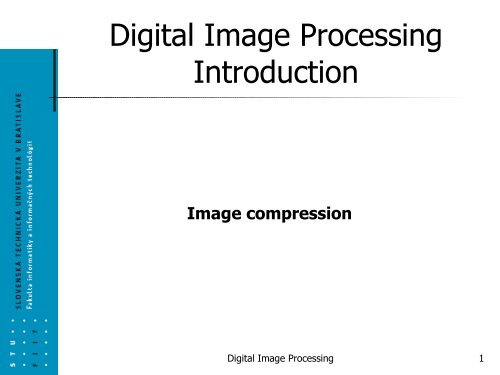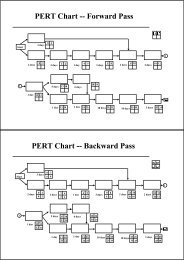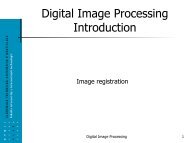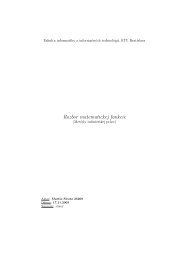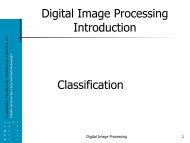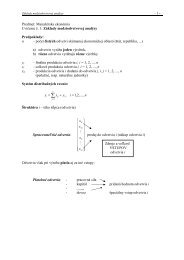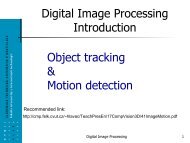Digital Image Processing Introduction
Digital Image Processing Introduction
Digital Image Processing Introduction
You also want an ePaper? Increase the reach of your titles
YUMPU automatically turns print PDFs into web optimized ePapers that Google loves.
<strong>Digital</strong> <strong>Image</strong> <strong>Processing</strong><br />
<strong>Introduction</strong><br />
<strong>Image</strong> compression<br />
<strong>Digital</strong> <strong>Image</strong> <strong>Processing</strong> 1
<strong>Image</strong> compression<br />
<br />
<br />
Data redundancy is a central issue in digital image<br />
compression.<br />
If n1 and n2 denote the number of information-carrying units<br />
in two data sets that represent the same information, the<br />
relative data redundancy RD of the first data set (the one<br />
characterized by n1) can be defined as<br />
<br />
<br />
<br />
Rd = 1 - 1/Cr<br />
where CR: - compression ratio, is<br />
CR = n1/n2<br />
<strong>Digital</strong> <strong>Image</strong> <strong>Processing</strong> 2
Three basic data redundancies:<br />
<br />
<br />
<br />
Coding redundancy<br />
Interpixel redundancy<br />
Psychovisual redundancy<br />
Data compression is achieved when one or<br />
more of these redundancies are reduced or<br />
eliminated.<br />
<strong>Digital</strong> <strong>Image</strong> <strong>Processing</strong> 3
Coding redundancy<br />
<br />
Variable-length coding.<br />
<br />
<br />
assigning fewer bits to the more probable gray levels<br />
than to the less probable ones achieves data<br />
compression.<br />
If the gray levels of an image are coded in a way that<br />
uses more code symbols than absolutely necessary to<br />
represent each gray level, the resulting image is said to<br />
contain coding redundancy.<br />
....<br />
<strong>Digital</strong> <strong>Image</strong> <strong>Processing</strong> 4
Interpixel redundancy<br />
<br />
spatial redundancy, geometric redundancy, and interframe<br />
redundancy, have been coined to refer to these interpixel<br />
redundancy.<br />
Illustration of run-length coding:<br />
(a) original image.<br />
(b) Binary image with line 100<br />
marked,<br />
(c) Line profile and binarization<br />
threshold.<br />
(d) Run-length code.<br />
Line 100: (1,63) (0,87) (1,37) (0,5) (1,4) (0,556) (1,62) (0,210)<br />
<strong>Digital</strong> <strong>Image</strong> <strong>Processing</strong> 5
Psychovisual redundancy<br />
<br />
<br />
Human perception of the information in an image<br />
normally does not involve quantitative analysis of<br />
every pixel value in the image.<br />
In general, an observer searches for distinguishing<br />
features such as edges or textural regions and<br />
mentally combines them into recognizable groupings.<br />
The brain then correlates these groupings with prior<br />
knowledge in order to complete the image<br />
interpretation process.<br />
<br />
Example - TV<br />
<strong>Digital</strong> <strong>Image</strong> <strong>Processing</strong> 6
<strong>Image</strong> Compression Models<br />
<br />
<br />
<br />
The Source Encoder and Decoder<br />
The source encoder is responsible for reducing or<br />
eliminating any coding, interpixel, or psychovisual<br />
redundancies in the input image.<br />
General compression system model:<br />
<strong>Digital</strong> <strong>Image</strong> <strong>Processing</strong> 7
Error-Free Compression<br />
<br />
<br />
<br />
<br />
<br />
<br />
Variable-Length Coding<br />
<br />
Huffman coding<br />
Arithmetic coding<br />
<br />
Unlike the variable-length codes described previously, arithmetic<br />
coding generates nonblock codes.<br />
Bit-Plane Coding<br />
<br />
the concept of decomposing a multilevel (monochrome or color)<br />
image into a series of binary images and compressing each binary<br />
image via one of several well-known binary compression methods.<br />
Constant area coding<br />
One/two -dimensional run-length coding<br />
Contour tracing and coding<br />
<strong>Digital</strong> <strong>Image</strong> <strong>Processing</strong> 8
Lossless Predictive Coding<br />
<br />
The approach, commonly referred to as lossless predictive coding,<br />
is based on eliminating the interpixel redundancies of closely<br />
spaced pixels by extracting and coding only the new information in<br />
each pixel.<br />
<br />
The new<br />
information of a<br />
pixel is defined as<br />
the difference<br />
between the<br />
actual and<br />
predicted value of<br />
that pixel.<br />
<strong>Digital</strong> <strong>Image</strong> <strong>Processing</strong> 9
Lossy Compression<br />
<br />
Unlike the error-free approaches outlined in the previous section, lossy<br />
encoding is based on the concept of compromising the accuracy of the<br />
reconstructed image in exchange for increased compression. If the<br />
resulting distortion (which may or may not be visually apparent) can be<br />
tolerated, the increase in compression can be significant<br />
Delta modulation (DM) :.<br />
<strong>Digital</strong> <strong>Image</strong> <strong>Processing</strong> 10
Transform Coding<br />
<br />
A transform coding system:<br />
Encoder + decoder.<br />
<strong>Digital</strong> <strong>Image</strong> <strong>Processing</strong> 11
Transform selection<br />
<br />
Walsh-Hadamard<br />
basis functions for<br />
N = 4.The origin of<br />
each block is at its<br />
top left.<br />
<strong>Digital</strong> <strong>Image</strong> <strong>Processing</strong> 12
Transform selection<br />
<br />
Discrete-cosine<br />
basis functions for<br />
N — 4. The origin<br />
of each block is at<br />
its top left.<br />
<strong>Digital</strong> <strong>Image</strong> <strong>Processing</strong> 13
Wavelet Coding<br />
<br />
the transform's basis functions—in this case wavelets—pack most of the<br />
important visual information into a small number of coefficients, the remaining<br />
coefficients can be quantized coarsely or truncated to zero with little image<br />
distortion.<br />
<strong>Digital</strong> <strong>Image</strong> <strong>Processing</strong> 14
JPEG standard<br />
It defines three different coding systems:<br />
<br />
A) a lossy baseline coding system, which is based on the DCT and is<br />
adequate for most compression applications;<br />
B) an extended coding system for greater compression, higher precision,<br />
or progressive reconstruction applications; and<br />
<br />
C) a lossless independent coding system for reversible compression. To<br />
be JPEG compatible, a product or system must include support for the<br />
baseline system.<br />
<strong>Digital</strong> <strong>Image</strong> <strong>Processing</strong> 15
JPEG 2000<br />
<br />
Although not yet formally adopted, JPEG 2000 extends the<br />
initial JPEG standard to provide increased flexibility in both<br />
the compression of continuous tone still images and access<br />
to the compressed data.<br />
For example, portions of a JPEG 2000 compressed image<br />
can be extracted for retransmission, storage, display, and/or<br />
editing.<br />
The standard is based on the wavelet coding techniques .<br />
Coefficient quantization is adapted to individual scales and<br />
subbands and the quantized coefficients are arithmetically<br />
coded on a bit-plane basis.<br />
<strong>Digital</strong> <strong>Image</strong> <strong>Processing</strong> 16


